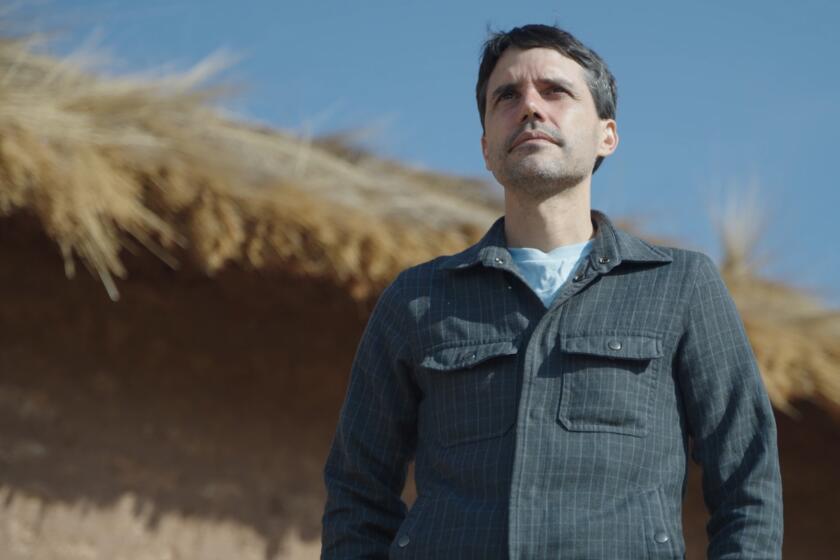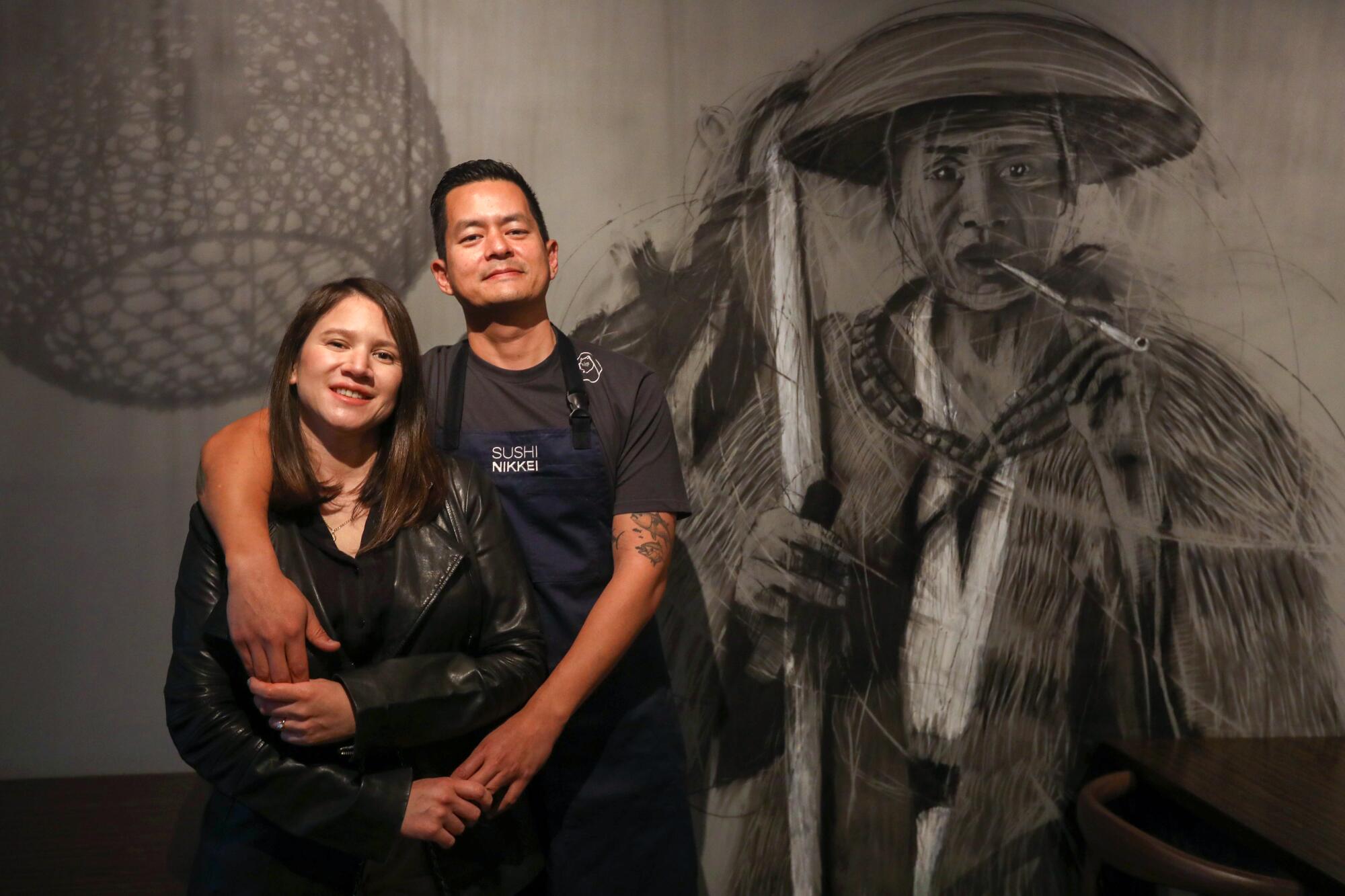
On a recent Sunday night in Long Beach’s Bixby Knolls neighborhood, chef Eduardo Chang and his wife and business partner, Daiwa Wong, greeted guests at Sushi Nikkei as they filed through the busy dining room to celebrate the restaurant’s two-year anniversary.
Chang and Wong specialize in Peruvian-style sushi, including various types of tiradito, such as yellowtail with jalapeño and ponzu sauce or the catch of the day with tiger milk, aji amarillo, cancha (toasted corn) and sweet potato. But on this night the couple served a special menu of traditional Peruvian dishes not usually found at Sushi Nikkei.
“You have to try it,” Chang said to a table of three, touting the seco norteño, braised short rib slow-cooked in cilantro sauce. “It’s only here for tonight. We wanted to spoil our guests.”
And there were many guests to spoil.
Each table in the 50-seat restaurant was filled and more guests were crowded at the door. Some were regulars, and Wong hugged them with the familiarity of an old friend.
Virgilio Martinez achieved the pinnacle of his profession when his Lima spot Central topped the World’s 50 Best Restaurants list in a country ignored by Michelin. He’s seeking more
“When you come in,” said Lakewood resident Samantha Rollins, who has been a customer since the restaurant opened, it’s “like they welcome you into their home. Everything here is made with love, made with meaning.”
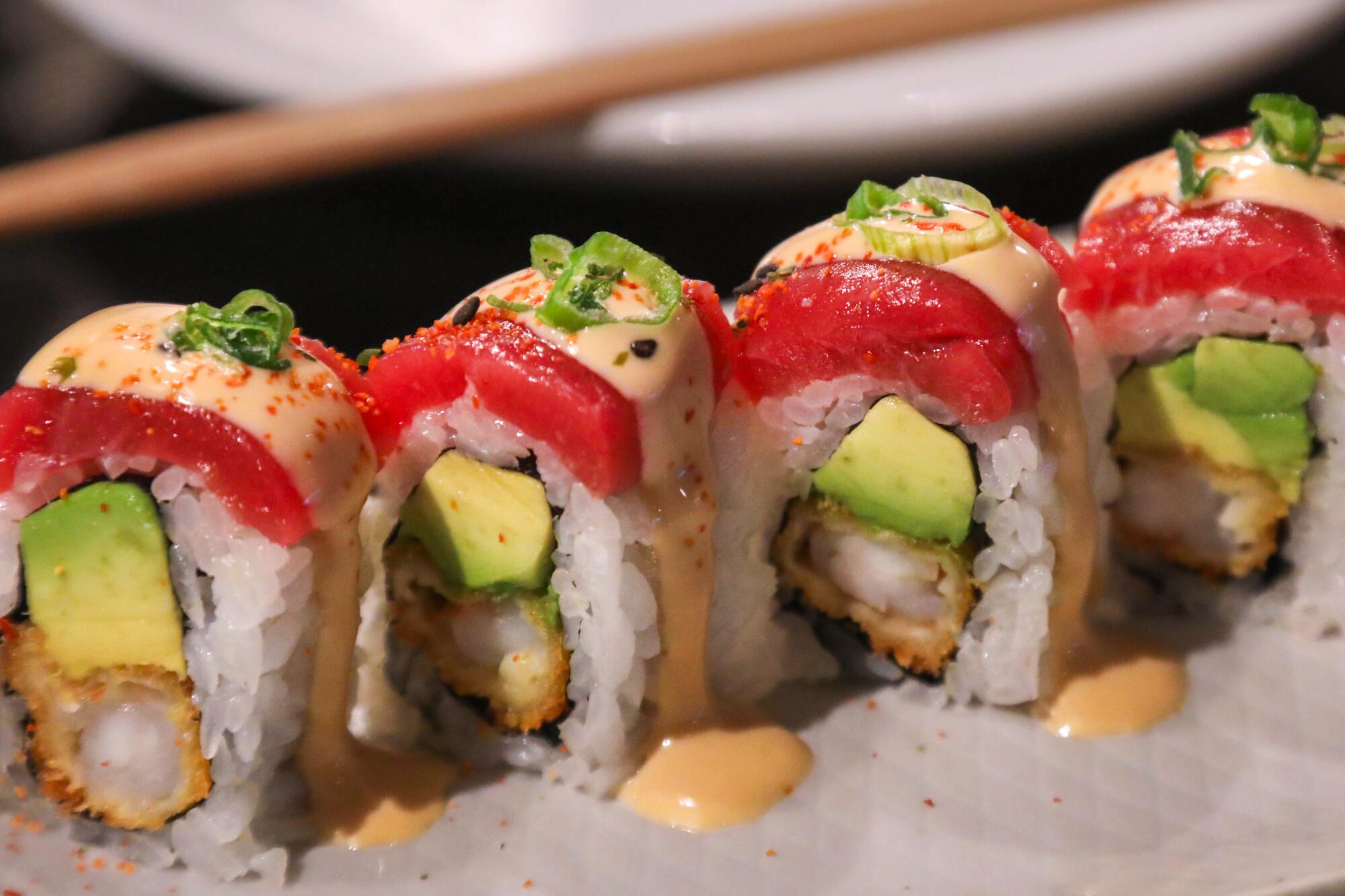
The connection between Peru and Japan goes back for generations, creating a unique thread in Peruvian life known as Nikkei culture. In two years, Chang and Wong have quietly built a following in Long Beach for their inviting dining room serving a sushi-focused take on Nikkei cuisine.
Peru established diplomatic relations with Japan in the late 1800s, and Japanese immigrants made their way to Peru when the industrial revolution made farming in Japan challenging. The migration began a long tradition of using Peruvian ingredients with Japanese culinary techniques.
Chang said he initially wanted to simply call the restaurant Nikkei — derived from the Japanese word Nikkeijin, which refers to Japanese emigrants from Japan, as well as their descendants. But the restaurant’s proper name is Sushi Nikkei — Peruvian Style.
“Here, people don’t know it so much,” said Chang. “People here would read it and not know what is Nikkei. So we added sushi, because they will recognize that.”
Chang and Wong opened their restaurant to share the Japanese-Peruvian cuisine Chang’s mother and grandmother cooked for him growing up. Along the way, the couple have become quiet ambassadors, sharing cultural history with diners, one sushi roll at a time.
“They see ‘Peruvian style’ and they think lomo saltado,” said Wong. “The challenge is to [raise] awareness of Nikkei cuisine.”
One of the signature dishes at Sushi Nikkei is a Parmesan scallop. The sweet scallop is brushed with lemon butter and draped over a perfectly formed nugget of rice, then topped with Parmesan cheese that gets toasted with a torch before being served. Parmesan and sushi might seem like an unexpected combination, but the smooth, rich bite is a close cousin of conchitas a la parmesana, a popular Peruvian dish of scallops broiled with Parmesan gratin.
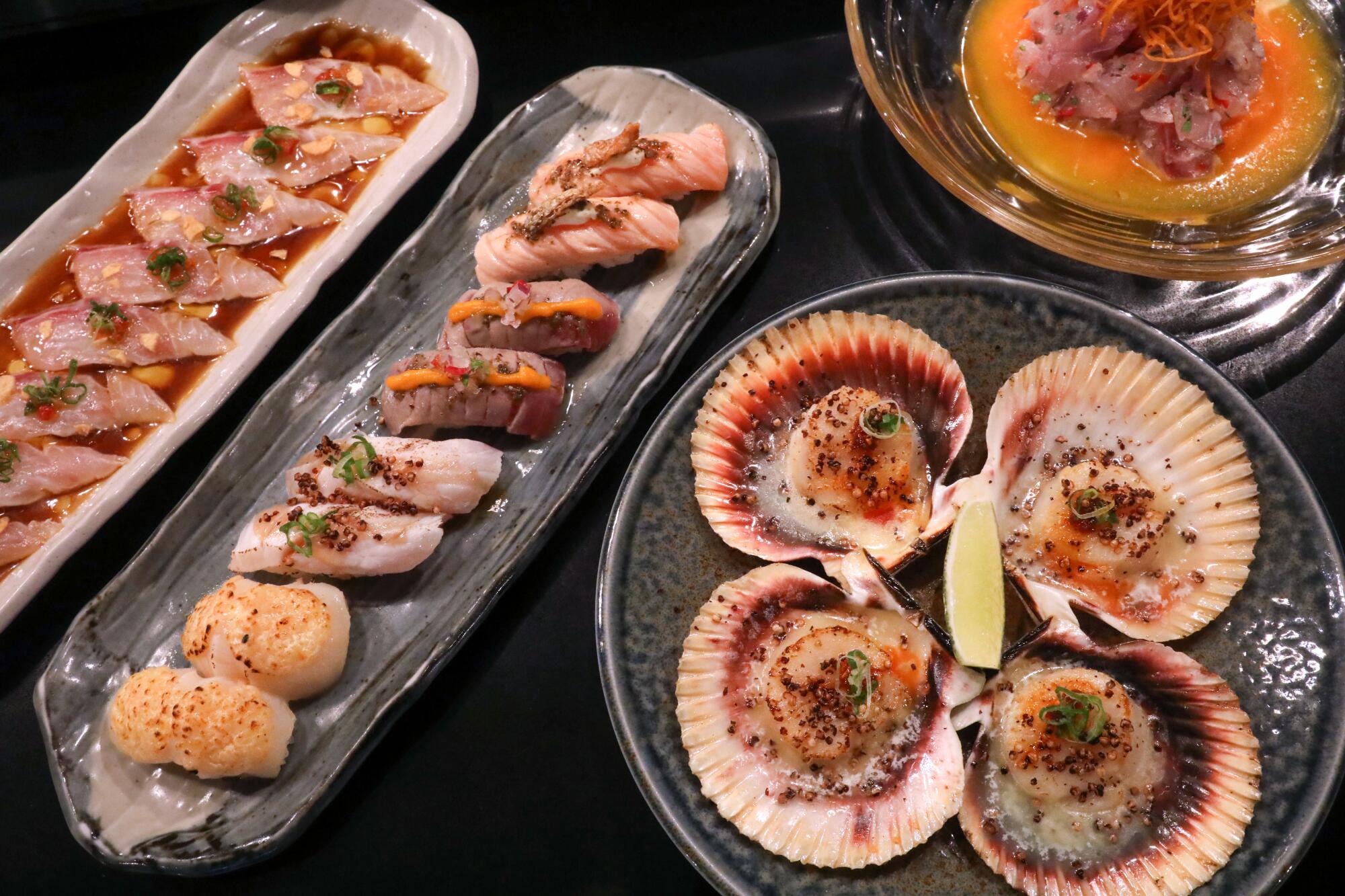
It’s an unexpected Nikkei dish that in a way reflects the notion that Nikkei cuisine at its core is about constant motion and fusion.
“Nikkei food is not intended to describe just Japanese-Peruvian food,” says Jane Matsumoto, executive culinary arts director at the Japanese American Cultural & Community Center in Los Angeles. “Nikkei food could be Japanese-American or Japanese-Mexican. Nikkei Peruvian is just one example of the many ways in which Japanese ingredients, Japanese techniques, Japanese foods and styles have been integrated into another culture.”
When groups re-create the food of their homeland in a new region, substitutions are made, flavors are replicated as best as they can be, and over time that new flavor becomes the tradition.
The Japanese influence in Hawaii resulted in dishes like Spam musubi, Matsumoto points out. There are even instances of amalgamation within the Asian diaspora in Latin America that can be traced in slightly more familiar Peruvian dishes, like lomo saltado. The 19th century brought indentured Cantonese workers to Peru and the steak and potato stir-fry is a staple of Chifa cuisine, a culinary tradition that blends Chinese and Peruvian culture.
Wong and Chang have their own family ties to Chinese culture. The couple first met in high school, at Colegio Peruano Chino Juan XXIII, a bilingual Catholic school in San Miguel, Peru. Wong’s mother, a teacher, and her father, a merchant, sent her and her brother to the school with the help of a scholarship, while Chang’s single mom worked as an accountant to support her two children.
“My husband and I, we were high school friends. We went to the prom together, but just as friends,” Wong said.
The two continued their friendship after graduation, but Wong left for the U.S. to find better opportunities and Chang attended Peru’s Cordontec culinary school. Wong gave birth to her first son and became a registered nurse, while Chang become an itamae sushi chef and eventually opened his first restaurant, Yume, in Lima.
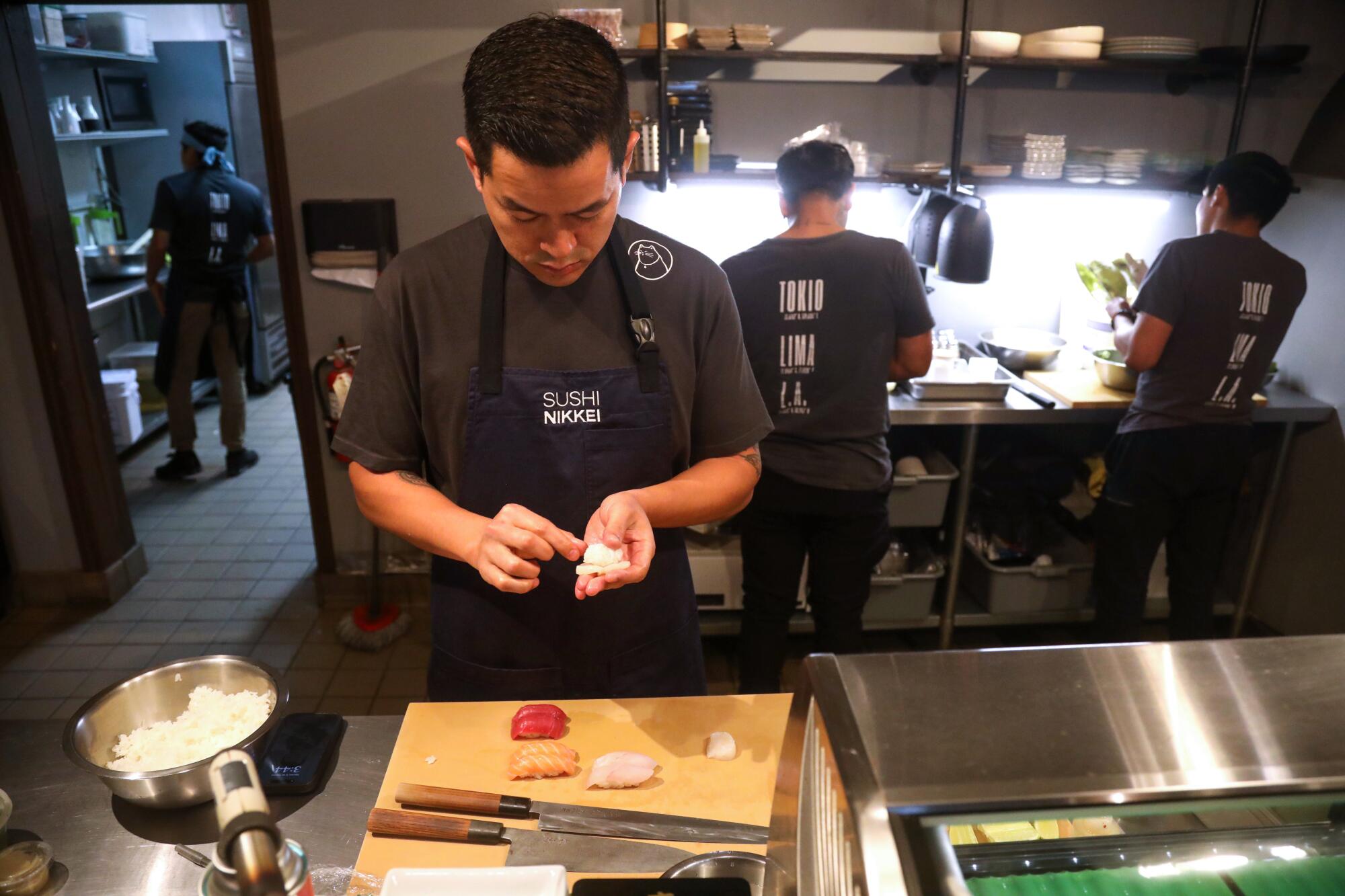
Chang came to the States to visit and their friendship eventually developed into a romance. They wed in 2018. By this time Chang and his partners had opened a second restaurant in Peru, but in 2019 he came to the U.S. permanently to be with his wife.
“He already opened his successful restaurant, but because of me he decided to leave everything behind and start all over again,” Wong said.
The couple had their first child together and, although they were happy, Wong said she felt guilty about Chang leaving Yume. In Peru, he was an accomplished chef and restaurateur, but in California, he rose early each morning to make sushi for a local grocery store chain.
“Our plan was to open our own restaurant,” said Wong, “I always told him, ‘I know we can do it. I trust your hands.’”
They worked hard and saved money for three years to secure a space: a former Mexican restaurant on Atlantic Avenue in Bixby Knolls.
“It was very different,” Wong said. “We remodeled every corner.”
They swapped fiesta orange and yellow for a subdued black-and-navy color scheme. The remodel also included adding a mural, sketched in a crosshatched black-and-white style, of a Japanese farmer, who now overlooks the dining room at Sushi Nikkei. The artwork, by Peruvian artist Rudolph Castro, is an imposing reminder of the cuisine’s history, a silent guardian of tradition.
Sushi Nikkei opened in January 2022 and by August, it was in the Michelin Guide as a “point of view” restaurant.
“Since we opened, we’ve had people. Every weekend, it was packed,” said Wong. A second Sushi Nikkei location followed in Belmont Shore in December of the same year.
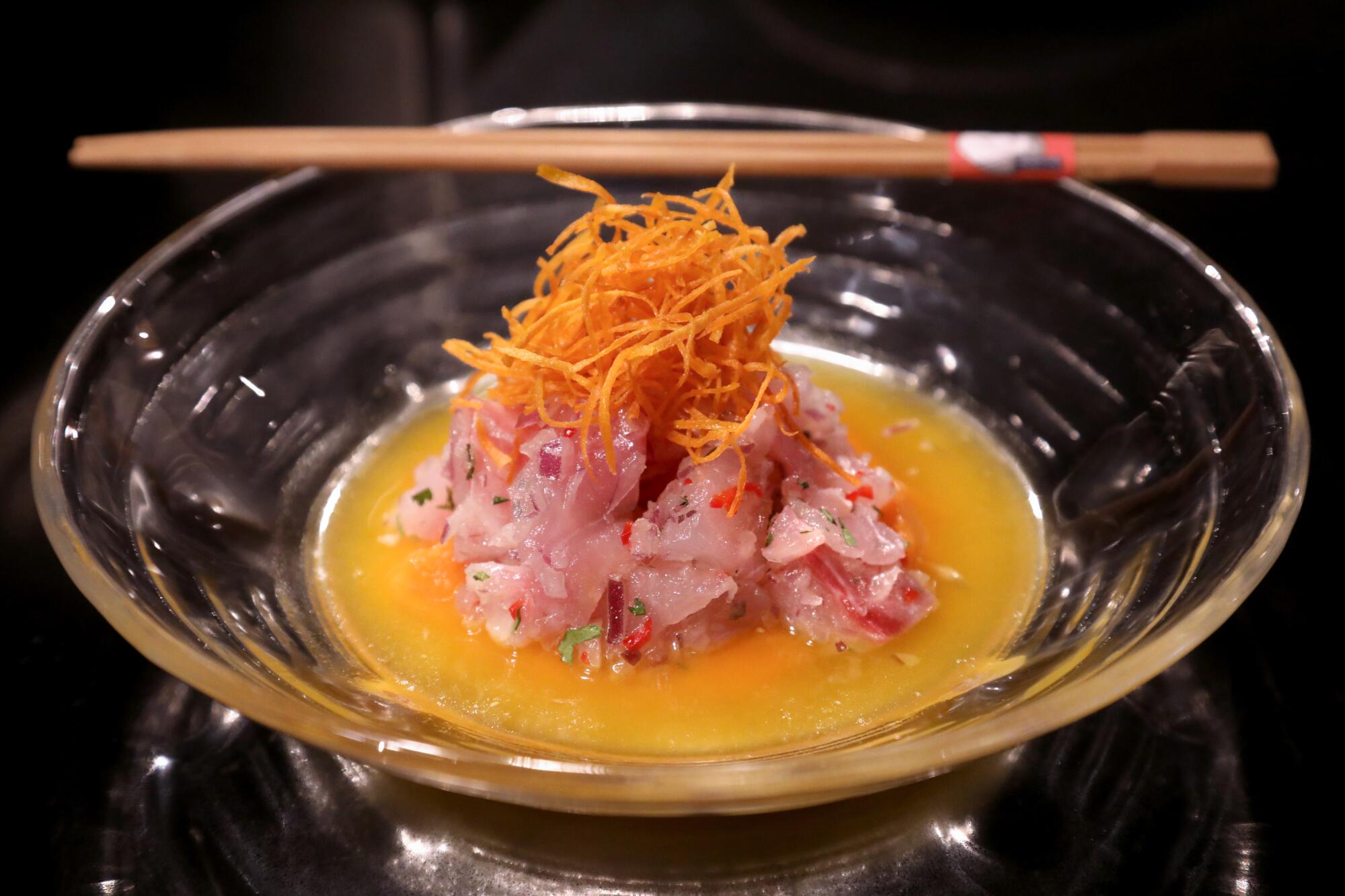
At both locations, the Parmesan scallop can be ordered on its own or as part of a tasting menu that includes three other types of sushi that are representative of Sushi Nikkei: Sweet Salmon, Tuna Power and Asian Shiromi. In addition to Parmesan, quinoa, cream cheese and aji amarillo peppers are among ingredients Chang incorporates into the Sushi Nikkei tasting.
“There are many people who don’t like the cream cheese in sushi, but with tuna, with salmon, it’s a good combination,” Chang said.
Cheeses, Matsumoto says, were incorporated into Japanese foods with the introduction of Western cultures and European cultures. The evolution of its usage continues today.
“Modern Japanese are putting cheese into Japanese croquets,” says Matsumoto. “I heard recently of someone putting cheese topping on okonomiyaki.”
For tiradito, another distinctly Japanese Peruvian tradition, raw fish is sliced like sashimi but spiced with ingredients like aji and lime rather than wasabi and shoyu.
Early Japanese immigrants also introduced Peru to the idea of eating a greater variety of seafood, including octopus and squid. A Sushi Nikkei menu item, Octopus Fire, is a culmination of both of these histories, presented as a row of thinly sliced octopus in citrus, parrillera sauce and a Peruvian salsa called chalaquita.
“Chalaquita is like Mexican pico de gallo,” Chang said.
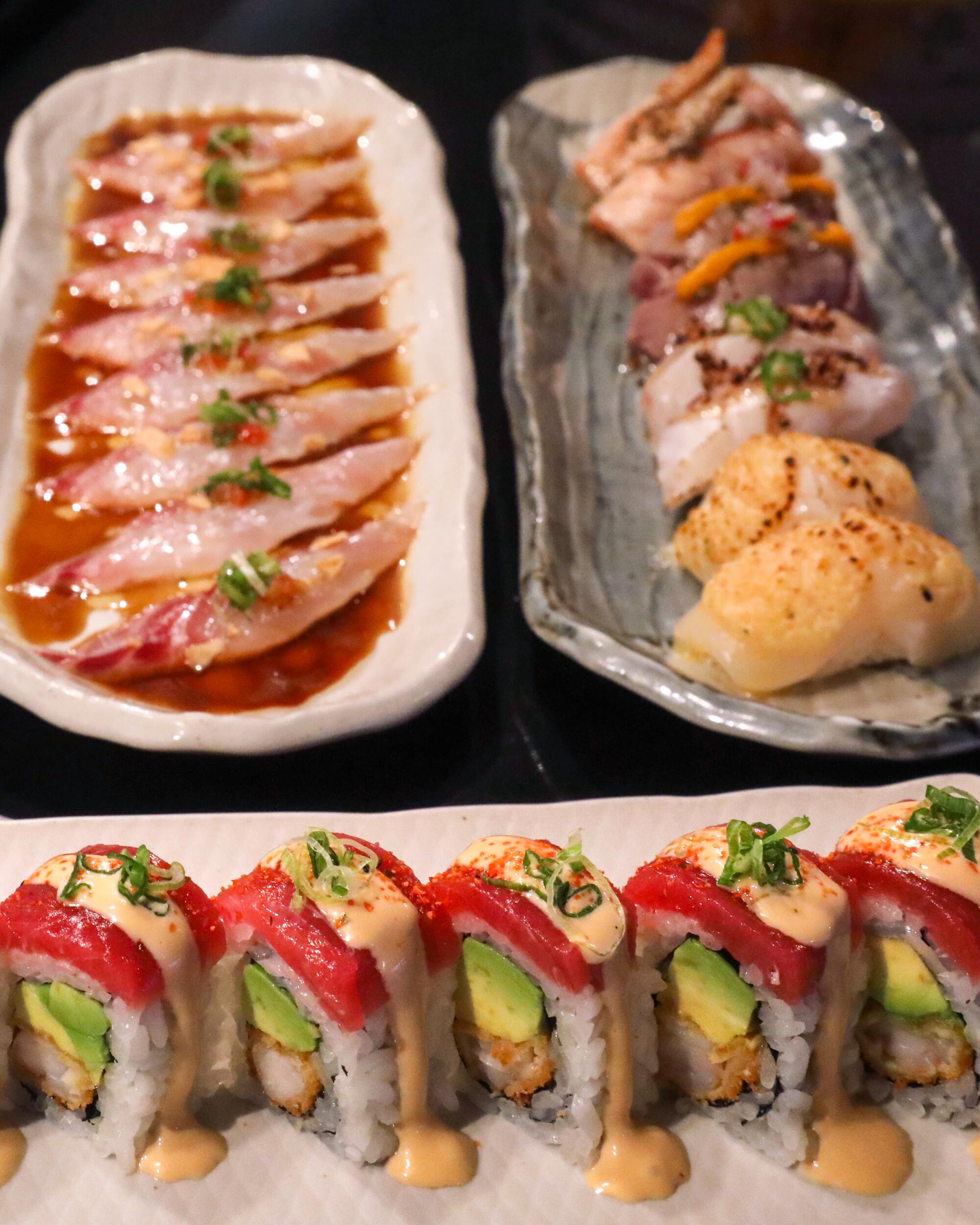
However, the Dusty roll — crisp shrimp and avocado, topped with octopus and finished with Parmesan cheese and orange hot sauce — isn’t named for anything Peruvian or Japanese. It was inspired by the cartoon character the couple’s young son is obsessed with — the orange plane called Dusty in Disney’s 2013 animated film “Planes.” It’s their way of working their own history into their style of Nikkei cuisine.
In 2023, the family became five, welcoming a baby girl. Wong still works as a nurse during the day and manages the Bixby Knolls restaurant by night. Chang handles the Belmont Shore location while Wong’s mother helps with their children. On the evening of the special anniversary menu, however, they worked together at the Bixby Knolls location. Wong moved through the dining room as usual, while Chang stood at the pass reading tickets and sending food to tables.
In the two years since the couple began their restaurant journey, they believe they have helped push Nikkei cuisine forward in Southern California — a generation after Nobuyuki “Nobu” Matsuhisa popularized Peruvian sushi in the U.S., first at Matsuhisa in Beverly Hills and later at his Nobu chain of restaurants.
Chang and Wong said they are proud to introduce their heritage to a community that is excited to appreciate it, helping diners like Rollins have their first experience with Japanese -Peruvian culture.
“Coming here, you learn a lot through a culture’s food,” Rollins said.
The work of sharing Nikkei culture is ongoing because it is an identity — like any other — that is always evolving.
In the weeks after the anniversary, guests call hoping to order the seco norteño, hungry for the tender beef and the rice and beans served alongside it. Wong regretfully informs them it was just a special, but she hopes they will have more special menus — and many more anniversaries — in the future.
“How many more years do we want to be here?” Wong said. “We want to be here forever.”
More to Read
Eat your way across L.A.
Get our weekly Tasting Notes newsletter for reviews, news and more.
You may occasionally receive promotional content from the Los Angeles Times.
